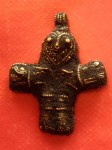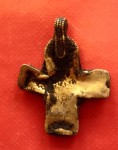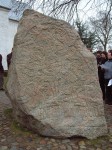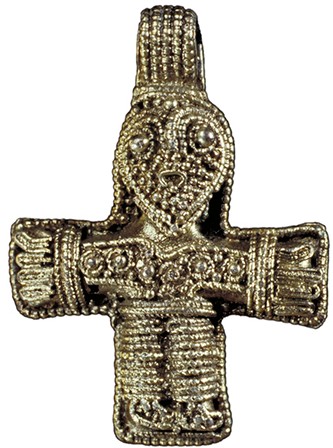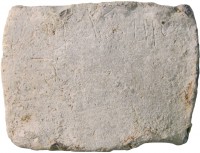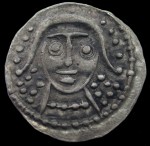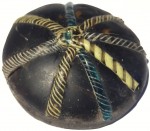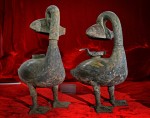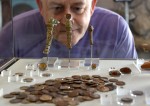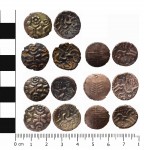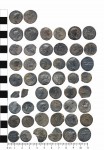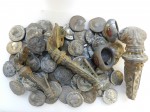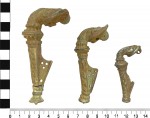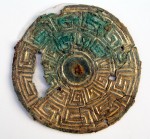 A buckle of Scottish or Irish origin has been discovered in the grave of a Viking woman in Enghøj on central Denmark’s Jutland peninsula. The gilt bronze disc is a small piece of six centimeters (2.4 inches) with a Greek key-like geometric pattern that was made in the 9th century. The woman who took it with her to the grave died in the 10th century, so it was already decades, maybe even a century, old when it was buried in Denmark. She used it to keep her petticoat together.
A buckle of Scottish or Irish origin has been discovered in the grave of a Viking woman in Enghøj on central Denmark’s Jutland peninsula. The gilt bronze disc is a small piece of six centimeters (2.4 inches) with a Greek key-like geometric pattern that was made in the 9th century. The woman who took it with her to the grave died in the 10th century, so it was already decades, maybe even a century, old when it was buried in Denmark. She used it to keep her petticoat together.
Archaeologist Ernst Stidsing from the Museum East Jutland realized right away that it was a very unusual piece. He’d never seen anything like it before, so he sent pictures to Emerita Professor Else Roesdahl of Aarhus University. She had never seen anything like it either. Stidsing shared the pictures with English and German colleagues and they agreed that it was made in the British Isles. Having only the ornamentation to go on, the experts disagreed on whether it was of Irish manufacture or from southern Scotland.
They were certain that it didn’t start out as a buckle or brooch. It was a fitting from a shrine of some kind, stripped off a wooden box used to hold sacred objects. It’s therefore not a trade piece. Monasteries and churches weren’t in the practice of prying the decoration off their reliquaries and selling them to Vikings. This was acquired in a raid.
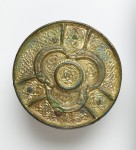 Viking loot from Britain and Ireland is very rare in Denmark, all the more so in a grave. It’s more common, albeit still a rarity, in Norway, where several examples have been discovered. A reliquary and fragment of an English 8th or 9th century crozier were found in the grave of a Viking woman in Romsdal, Norway, in 1961. A direct parallel, a Celtic disc, also originated in Scotland or Ireland as decoration on a shrine or reliquary. The Vikings converted into a brooch and it was buried the grave of a high-status woman in Lilleberge, Norway, in the 9th-10th century. It was unearthed in 1886 but kept in a soil block and only fully excavated and identified a few years ago.
Viking loot from Britain and Ireland is very rare in Denmark, all the more so in a grave. It’s more common, albeit still a rarity, in Norway, where several examples have been discovered. A reliquary and fragment of an English 8th or 9th century crozier were found in the grave of a Viking woman in Romsdal, Norway, in 1961. A direct parallel, a Celtic disc, also originated in Scotland or Ireland as decoration on a shrine or reliquary. The Vikings converted into a brooch and it was buried the grave of a high-status woman in Lilleberge, Norway, in the 9th-10th century. It was unearthed in 1886 but kept in a soil block and only fully excavated and identified a few years ago.
Ernst Stidsing thinks there may have been a Norwegian connection for the Enghøj buckle.
“It could have been [brought by] a Norwegian woman who came to Denmark with her jewellery, and lived and died there,” says Stidsing.
He now hopes that strontium isotope analysis of the woman’s teeth could clear up where she came from.
“I’m pretty excited about the outcome of the analysis,” says Stidsing. “Especially as the Norwegian Vikings were often on expeditions to the north of England. It’s exciting that a woman may have come from Norway and have lived part of her life in Jutland [west Denmark].”
“It will confirm the picture that we were already [living] in a globalised world back then,” he says.
That picture was solidly confirmed most recently when Egtved Girl, the Bronze Age young woman whose exceptionally preserved burial complete with hollowed out tree trunk coffin, clothing, grave goods, textiles and accessories has become a Danish icon since its discovery in 1921, was actually from Southern Germany. Egtved Girl was a very important person even though she was only 16-18 years old when she died, a priestess or a dynastic bride, and it’s known that there were marriages between Danish kings and Slavic princesses starting in the 10th century. The woman who was buried with the buckle had status and wealth, but she wasn’t a princess. If isotope analysis finds that she was from Norway or somewhere else other than Denmark, it will give new insight into how mobile Vikings were at various social levels.
